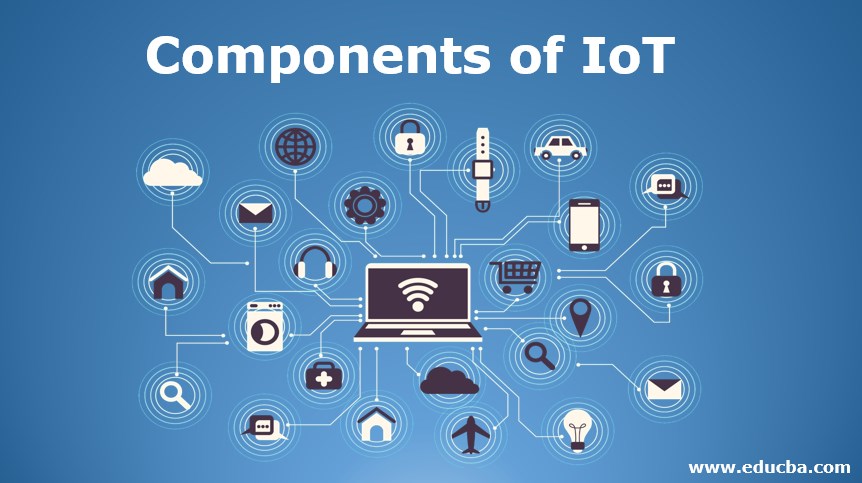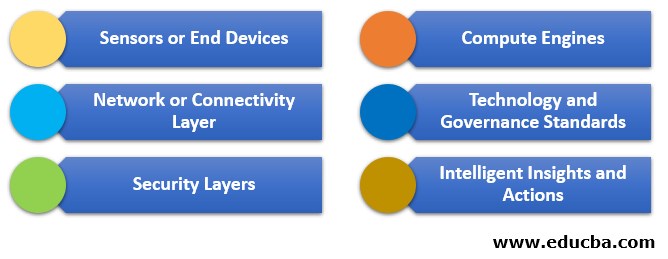Updated August 10, 2023

Introduction to Components of IoT
With the increasing bandwidth availability and cheap hardware cost, IoT is changing the industry landscapes in scale. From medical, construction, governance to Insurance, BFS the use cases of IoT are spreading day by day. The IT spending of multinational corporations, banks, and other institutes are also increasing along with all these developments. Though the hardware, software and infrastructure requirements of Industry grade IoT differ from domain to domain, the basic components remain the same. In this article, we will discuss the standard components of an IoT system.
Key Components of IoT
We can list down the below components as key parts of an IoT ecosystem.

1. Sensors or End Devices
For any IoT use case, the components of the endpoint are sensors. Sensors capture electric pulse or analog signals which are passed through the IoT ecosystems. Based on the use case and domains RFID, temperature sensors, light sensors, electromagnetic sensors, etc. are used. For example, smartphones and smart wearables are equipped with sensors like accelerometer, Gyroscope sensors, etc. Data obtained from these IoT endpoints can be used in various domains like Human activity recognition, medical stability, etc. Based on the use case and precision requirements sensors can be chosen keeping the following parameters in mind
- Accuracy of the input readings
- Reliability percentage of the inputs
- The purpose of the use case, for example, sensors required for a temperature-dependent use case, will differ from use cases based on motions.
- Industry grade IoT systems can be integrated with multi-technology, cross-functional and cross-vendor products. Based on the complexity and compatibility sensors are chosen for a particular use case.
2. Network or Connectivity Layer
In a typical IoT ecosystem, sensors are connected with computation layers and intelligent layers via network or connectivity layers. IoT endpoints need to be always connected with various other components seamlessly over the connectivity layer. Based on the scale of the implementations IoT components can be connected overs LANs, MANs or WANs. It can also be connected through telephony networks like LTE (Long Term Evolution or popularly known as 4G Network) or light-based technologies like Li-Fi (where light is used as a mode of communication to maintain interconnections). For local use cases, Bluetooth and Wi-Fi can also be used.
An IoT network consists of various network components like routers, gateways, switches, various network protocols, etc. Based on the use case and domain proper network infrastructure is needed to be chosen.
3. Security Layers
The heart of any industry-grade IoT user story is ‘data’. In a standard use case, analog or digital signal is acquired by sensors and the signal is then converted to a format on top of which AI/ML components can work. In the total flow of data, proper security systems and methodologies need to be enforced. The data can be compromised in any layers starting from the data acquisition to business insights derivations. We can enforce proper security by using strong encryption in various layers of communication, using proper firmware and anti-malware systems, etc.
4. Compute Engines
Industry grade IoT systems typically use multiple technology stacks inside an umbrella. For example in insurance premiums can be calculated as a variable component as per the driving pattern of the insurer. The data collected from smart devices are converted and preprocessed to a format on which machine learning models are developed. Customers can use any cloud partners of their choice or develop their own infrastructure to execute a use case.
For example, the compute engines from PaaS (Product as a service) or IaaS (IoT as service) will differ from on-premise systems.
5. Technology and Governance Standards
Sensitive information flow over the various components of the IoT ecosystem. To cope up with this the systems need to adhere to proper technique and governance standard and KPIs
- Typical Technical standards: Wi-Fi, WAN, etc.
- Network Protocols: HTTP, TCP/IP, UDP, etc.
- Data management standards: ETL, CAP (for distributed systems), etc.
- IoT systems need to follow the regulations and quality standards of respective regulatory authorities and business standards.
6. Intelligent Insights and Actions
Most of the practical and industry-grade IoT use cases are intended to derive business insights or actionable recommendations. The preprocessed data need to be integrated with ML components and the trained models are deployed to the production environment. The choice of the technology stack to develop the intelligent business component is dependent on the compatibility with the in house existing systems, the scale of the business, the complexity of the use case, and precision and latency requirements of the domain, company partnerships, etc.
For example in the heavy manufacturing industry, the data obtained from various machinery can be used to predict the fault of the machine which can help to reduce manufacturing downtime and increase efficiency.
Conclusion
In this article, we have discussed the various building blocks of the industry-grade IoT systems. The field of IoT and related technology stack is still an active area of research and still far from adhering to any globally recognized standard components. Though here we discussed the typical components of an IoT use case, the components may differ based on domain, use case, and organization.
Recommended Articles
This is a guide to Components of IoT. Here we discuss the brief overview and different Components of IoT with detail explanation. You may also look at the following articles to learn more –

